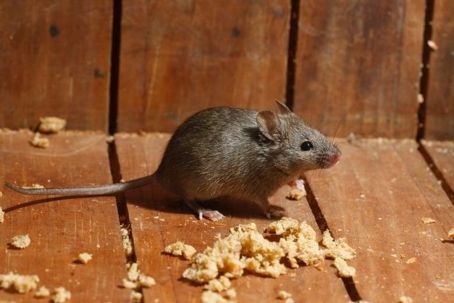Mouse Damage
Mice can cause a surprising amount of damage to both homes and businesses, often in ways that are not immediately obvious:
Structural Damage
Gnawing on wood, drywall, and insulation: Mice constantly chew to keep their teeth from overgrowing. This can damage walls, baseboards, furniture, doors, and even support beams.
Chewing through pipes and ductwork: Mice can damage plumbing insulation and HVAC ducting, leading to water leaks or reduced system efficiency.
Damaging insulation: Nesting mice can shred insulation in attics and walls, reducing its effectiveness and increasing energy costs.
Electrical Hazards
Chewing electrical wires: One of the most dangerous consequences. Exposed wires from gnawing can cause short circuits, power outages, or even fires. Electrical damage in commercial buildings can be particularly costly and hazardous.
Contamination and Health Hazards
Food contamination: In homes, restaurants, grocery stores, or warehouses, mice can contaminate food with saliva, urine, and feces. This not only ruins products but can also trigger foodborne illness outbreaks.
Spreading pathogens: Mice carry bacteria and viruses (e.g., Salmonella, E. coli, Hantavirus) that can contaminate surfaces, HVAC systems, and stored goods.
Odor problems: Accumulated urine and droppings create persistent, unpleasant odors. Nesting materials can also produce a musty smell.
Property and Cosmetic Damage
Gnaw marks on furniture and personal items: Mice chew on items they come across, from cardboard boxes and paper products to plastics, leather, and fabrics.
Damage to stored goods: In businesses like warehouses, retail stores, and restaurants, mice can ruin packaging and inventory, leading to significant financial loss.
Economic and Operational Impact
Business interruptions: Infestations can lead to temporary closures, especially in food-related businesses, until health and safety standards are restored.
Repair and remediation costs: Structural repairs, electrical rewiring, insulation replacement, and cleanup of contaminated areas can be expensive.
Reputation damage: For commercial establishments, evidence of mice can damage public perception, resulting in lost customers and revenue.
Mice are far more than a nuisance—these small rodents can compromise structural integrity, create serious fire and health hazards, and lead to substantial financial losses. Early detection and control are critical to minimizing these risks.
What Does Mouse Damage Look Like?
Mouse damage can manifest in several visible and subtle ways, depending on whether it’s structural, electrical, or contamination-related. Recognizing the signs early is crucial for preventing more serious problems:
Gnaw Marks
Wood, plastic, and drywall: Mice leave small, rough-edged chew marks about 1/8 to 1/4 inch wide. Common areas include baseboards, furniture legs, cabinets, and door frames.
Electrical wires: Look for frayed or stripped insulation, often with teeth marks. This is a serious fire hazard.
Food packaging: Chewed boxes, plastic containers, and bags with small bite marks are clear signs of infestation.
Droppings and Urine Stains
Droppings: Small, dark, cylindrical pellets about 1/4 inch long are usually found along walls, behind appliances, or in cupboards. They may look similar to rat droppings but are smaller and more pointed at the ends.
Urine stains: May appear as yellowish streaks or smears, often near nesting sites or travel paths. Urine can also leave a strong ammonia-like odor over time.
Nesting Materials
Mice shred paper, cardboard, insulation, or fabric to build nests. Nests are often hidden in wall cavities, attics, basements, or storage boxes.
You may also see tufts of fur mixed in with the nesting material.
Structural Damage
Holes and tunnels: Mice chew small holes (about 1/2 inch in diameter) to enter walls, ceilings, and stored goods. Look around utility pipes, vents, and foundations.
Damaged insulation: Insulation may appear shredded or clumped together, often near warm areas like attics or HVAC ducts.
Smudges and Tracks
Grease marks: As mice travel along walls and floorboards, their oily fur can leave dark smudge marks, particularly along frequently used paths.
Footprints: In dusty areas, tiny footprints with 4 toes in front and 5 behind may be visible.
Where Is Mouse Damage Found?
Mouse damage is most commonly found in areas that provide food, warmth, water, and shelter. Mice are very good at hiding, so the damage is often subtle at first. Here’s where to look in homes and businesses:
Kitchens and Food Storage Areas
Cabinets and pantries: Look for chewed food packaging, droppings, and gnaw marks on shelves or boxes.
Under sinks: Mice are attracted to water and warmth. Look behind plumbing and under cabinets.
Appliances: Refrigerators, ovens, and dishwashers often hide small mouse nests or droppings along the back or underneath.
Attics, Ceilings, and Roof Spaces
Insulation: Shredded or clumped insulation indicates nesting.
Wood beams and rafters: Gnaw marks on structural wood are common.
Attic corners: Droppings, urine stains, and nesting material accumulate along edges and hidden corners.
Basements, Crawlspaces, and Utility Areas
Foundations and wall gaps: Small holes for entry, gnaw marks on wood or pipes.
Behind boxes and stored items: Mice often nest in cardboard, paper, or fabric stored on the floor.
Near HVAC systems or water heaters: These areas provide warmth and shelter.
Walls and Wall Cavities
Holes near electrical outlets or plumbing: Mice gnaw through drywall to travel between rooms or access food and nesting areas.
Inside walls: You may hear scratching or scampering at night; check for droppings or grease smudges near holes.
Offices and Commercial Spaces
Storage rooms and warehouses: Chewed packaging, shredded paper, and gnaw marks on shelving or pallets.
Break rooms: Food storage cabinets, trash bins, and refrigerators are hotspots.
Electrical rooms: Wires and conduits may show gnaw damage.
General Indicators Anywhere Mice Travel
Along walls and corners: Look for dark grease smudges or footprints in dusty areas.
Near heat sources: Mice prefer warm areas like behind heaters, furnaces, or under radiators.
Near water sources: Leaky pipes, sinks, and condensation-prone areas attract mice.
Mice tend to stick close to walls, hidden corners, and protected areas while staying near a reliable food or water source. Damage is often subtle and concentrated, so thorough inspection of less obvious areas is critical.

